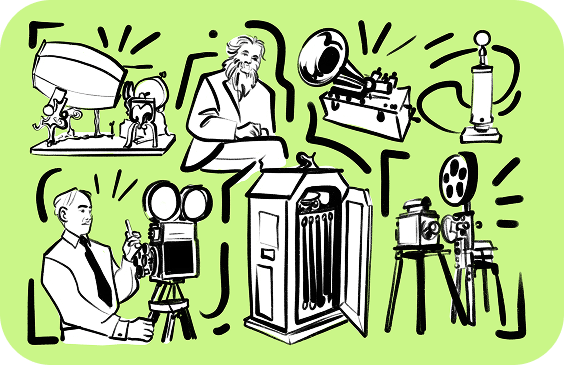From silent films to immersive sound design
A modern person can hardly imagine watching a film without sound: the acoustic ornamentation, carefully selected atmospheric tracks, voice acting — all these elements shape the unique ambiance of each cinematic work. One can only speculate how today’s audience would feel after watching a silent movie. The earliest films lacked meticulously layered soundtracks, background special effects, and professional music scores. As for high-quality sound — that remained a distant dream. But if all of this was once absent, how did cinema manage to evolve into such a rich auditory experience?
We invite you to explore the answer to this question from two perspectives: the development of life’s everyday tools and the advancement of progressive technologies. Perhaps, through this lens, we’ll discover how films found their voice — and immerse ourselves in the fascinating world of music.
The evolution of musical accompaniment in films began relatively recently — at the end of the 19th century. The first motion pictures were produced entirely without sound — they were simply moving images, depicting scenes from everyday life. One of the earliest examples of such visual storytelling was the Lumière brothers’ film Arrival of a Train at La Ciotat Station, released in 1895.
At the time, witnessing a train approaching on a square screen was already a marvel in itself. But as time went on, both audiences and filmmakers longed to amplify the emotional impact of what they were watching, and people began to think about how this could be enhanced.
In the earliest movie theaters, films were accompanied by tapeurs— musicians who played light background music on the piano or other instruments. If the cinema was large, an entire symphony orchestra might provide live accompaniment during a screening. The profession’s name, tapeur, comes from the French word meaning “to tap” or “to knock.” Often, the instruments they played were far from top-quality, and the musicians had to pound them with their fingers just to produce any sound at all.
The new profession captivated the youth, and many musicians we now recognize as renowned also tried their hand as musical accompanists. The most celebrated tapeur in the Soviet Union was Dmitri Shostakovich. In 1923, at the age of seventeen, he completed his piano studies at the Leningrad Conservatory and took a position as a cinema pianist-illustrator. He first worked at the “Svetlaya Lenta” theater, and later at the “Splendid Palace.” His teacher, Leonid Vladimirovich Nikolaev, advised him: “If you’re going to play in a cinema, then improvise.”
Shostakovich took his mentor’s advice to heart, and more than fifteen years later, in an interview with the newspaper Vechernyaya Moskva (1940), he recalled:
“While studying at the Leningrad Conservatory in both piano and composition, I was also employed at one of the city’s cinemas. At that time, there were no sound films yet, and screenings were accompanied by piano, with tapeurs playing popular marches and waltzes. I, however, indulged my passion for improvisation. It fascinated me deeply, and even long afterward — even now — I compose many pieces I never publish. These are a kind of composer’s exercises.”
Music for silent films was originally drawn from composed material — performers would play popular songs and vaudevilles — but most artists still preferred improvisation. A tapeur had to be able to play in any musical style, in order to best express the character of the film. These musicians were true masters of their craft: they closely watched the visuals, responded to even the slightest shifts in mood, and played their instruments simultaneously. It was especially challenging in the early years of silent cinema, when the equipment would freeze or speed up the film. In such moments, the musicians had to adapt instantly, softening the audience’s displeasure with quick musical adjustments.
At the end of the 1920s, a new wave of cinematic development began, heralding the birth of sound film. Scientific minds became captivated by experimentation, and innovative instruments soon joined forces with orchestral sound.
One such instrument was the theremin. Its prototype was based on an electrical oscillation generator using a cathode tube. Lev Theremin, a Soviet inventor and musician, created his instrument in the 1920s to prove that electricity, too, could produce sound — and he succeeded! The principle of playing the theremin involved the performer’s hands and fingers moving without touching the instrument. Sound was generated through the performer’s influence on the device’s electromagnetic field. Inside the instrument were two oscillators — one fixed-frequency and one variable — along with two antennas: one controlled volume, the other pitch.
The theremin astonished and captivated the public, instantly becoming a source of national pride. It continues to be widely used in cinema to this day, especially in science fiction films.
Director Alfred Hitchcock was the first to use the theremin to create an atmosphere of horror and mystery. It was he who set the trend for the instrument’s widespread adoption in cinema. The first horror film to feature the theremin — Spellbound, released in 1945 — instantly became a striking example of unsettling, blood-chilling musical accompaniment. Thanks to Samuel Hoffman, who performed the theremin parts with bold, sweeping vibrato, this distinctive sound was born. From that moment on, the instrument gained significant popularity in both the West and Europe.
Later, the theremin became the “voice” of outer space in films such as The Day the Earth Stood Still and It Came from Outer Space, as well as the sound of the future. In the Soviet comedy Ivan Vasilievich Changes Profession, the theremin was used to accompany the scene involving the launch of a time machine.
Alongside the theremin, another instrument emerged — the ondes Martenot. It appeared in 1928 and served as a prototype for the modern synthesizer. The invention featured a seven-octave keyboard, a wire with a ring for the right index finger, a button that functioned like a bow, and a switch for adjusting tone and control modes. Though monophonic, the instrument quickly won the hearts of filmmakers, as it could produce anything from a velvety bass to a piercing, heartbreaking wail. Its dynamic range — from pianissimo to fortissimo — and its varied sound-producing techniques could even mimic the sound of shattering glass. The haunting tones of the ondes Martenot can be heard in the scores of films such as Lawrence of Arabia, My Left Foot, Ghostbusters, Amélie, and many others.
Gradually, music in cinema ceased to be merely an accompaniment — it became an integral part of the film itself. With the help of music, directors concealed their mistakes: flaws in the visual sequence, poor editing, awkward angles, misframed shots, uneven lighting. The demand for new sound effects was constantly growing. It wasn’t enough for the audience to feel uneasy — they needed to scream in terror! As a result, even classical instruments underwent bold experimentation.
Some acoustic instruments were transformed into electronic ones. This is how the synthesizer came to be. The instrument borrowed its appearance and playing principles from the piano, while its ability to manipulate tonal color was inspired by the ondes Martenot.
The first film to feature the sound of the synthesizer was A Clockwork Orange (1971). Composer Wendy Carlos recorded its soundtrack with powerful arrangements — she managed to create an atmospheric and chilling reinterpretation of classical works.
Orchestral instruments also played a significant role in crafting cinematic atmospheres. The piano was used as a string instrument — the pianist would play directly on the strings of the grand piano using pizzicato and staccato techniques. Various objects were used to extract sounds: bolts, nuts, rubber, and plastic. String instruments, too, were modernized — to achieve a metallic, scraping sound, clips were attached to the strings, and special techniques were employed, such as playing with the wooden stick of the bow behind the bridge (near the fingerboard).
In cinema, instruments began to sound in entirely new ways, giving rise to numerous auditory stereotypes and patterns. One such example is the sound of the organ. It has become customary to associate the organ with feelings of dread or mourning in films: viewers instantly envision Catholic cathedrals, natural disasters, crypts, and the undead. Yet there are also instances where organ music evokes something uplifting — or even parodies a situation entirely.
Sure! Here’s your full, unsimplified and literary-style English translation with proper quotation marks and rhythm:
The most popular organ piece — Toccata and Fugue in D minor by J.S. Bach — is used in a huge number of films, though always with a different subtext. For instance, in Federico Fellini’s La Dolce Vita, amid the bubbling chaos of high society, the melody becomes a symbol of loneliness and longing for an ideal family life. In The Phantom of the Opera, the context changes: the toccata theme becomes an ominous foreshadowing — a suspenseful expectation of the protagonist’s encounter with the Phantom. At the very moment the organ solo plays, the girl is kidnapped.
A sense of horror is palpable in the film Castle of Nightmares. A natural disaster is masterfully portrayed in the second part of Pirates of the Caribbean, where Captain Davy Jones plays the organ. The feeling of spiritual elevation can be experienced in Andrei Tarkovsky’s Solaris.
Sound designers and special effects artists in cinema often rely on improvised tools as well. For instance, sheets of aluminum are used to simulate thunder, rusty hinges replicate the creaking of swings or doors, and the sound of horse hooves is imitated using coconut shells.
It is difficult to determine which kind of music — acoustic or electronic — has a greater impact on sound effects and the human perception of film. Electronic sound helps to emphasize the scientific, technical, and fantastical aspects of the plot, whereas acoustic music, performed on familiar instruments, more effectively conveys emotion and atmosphere. The choice of sound ultimately depends on the director, their creative vision, and the specific nuances of the film’s narrative that need to be highlighted.
Directors often make references to other musical works in their films. For example, when composing the music for The Shining, the musician was inspired by the works of second-wave avant-garde composers such as György Ligeti, Béla Bartók, Krzysztof Penderecki, and others. The film’s composers, Wendy Carlos and Rachel Elkind, recorded the soundtrack Dies irae, in which one can discern the finale of Hector Berlioz’s Symphonie Fantastique. The famous “B-A-C-H” theme, constructed from the notes of Johann Sebastian Bach’s name, fully unveils the film’s ending, foreshadowing its tragic revelation.
To fully appreciate the connection between the musical work and the film, let’s imagine what The Shining would be like if the music were arranged by another composer, such as Joe Hisaishi — the composer behind the suites for Hayao Miyazaki’s animated films.
The film would be perceived differently: lighter, with sarcastic notes creeping into the scenes of “horror,” and perhaps even a glimmer of hope for the future, despite the well-known ending. It is astonishing how the stylization of the musical accompaniment can alter our perception of a film in a matter of seconds, shifting it from terror to a more tranquil atmosphere.

Sound recording began to intrigue inventors separately from cinema. The phonautograph, invented by Édouard-Léon Scott de Martinville in 1857, was one of the first devices to capture sound.
The idea of creating “sound pictures” was conceived by photographer Edward Muybridge and inventor Thomas Edison in 1878. This led to the invention of a new device: the phonograph. The apparatus consisted of a gigantic horn, which one had to approach closely for better sound recording, and special wax cylinders. The horn collected sound waves, concentrating them inside itself, while a needle would cut sound patterns onto rotating mechanical discs through these vibrations. The recordings primarily featured loud music, mainly orchestral, in an attempt to capture a fuller, richer sound. The equipment was rudimentary, with no amplifiers for the sound. But from this era, one principle has endured — the louder the sound, the easier it is to record.
Later, Edison invented the Kinetoscope, a device for viewing moving pictures. Unlike modern film projectors, the Kinetoscope allowed only one person at a time to view a film through a special eyepiece. In 1895, to combine video and sound, the Kinetophone was invented. The team at General Electric, managed by Thomas Edison, almost succeeded in bringing together all these developments into one unified device.
The Kinetophone was a commercial invention. Anyone could watch a film for a small fee, and the novelty became a popular attraction. Edison believed that cinema would not develop further, but in 1900, he presented three improved versions of the Kinetoscope: the Phonorama, Chromophone, and Phono-Cinematheatre.
Thanks to American inventor Lee De Forest, who in 1906 introduced the world to the three-electrode vacuum tube with a grid control electrode – the triode – the first sound amplifiers appeared.
Using this, De Forest created a completely new sound recording system – the “Phonofilm.” Its uniqueness lay in combining video with optical sound recording: by controlling and directing light onto the photomaterial, an electrical signal would appear, and sound would be recorded through light on a moving light-sensitive film.
Unfortunately, De Forest’s invention did not achieve great success due to poor sound quality and the rise of silent cinema, but it served as a prototype for subsequent innovations.
In 1916, Edward Wente, an engineer at Bell Laboratories, developed a prototype of the first condenser microphone. It was just a sample, but this development played a crucial role in future progress.
Next, Warner Bros. Pictures produced its optical sound recording system — Vitaphone. During recording, discs were used that allowed a large amount of information to be recorded for up to 10 minutes. Each disc was used 20 times before being replaced with a new one. For sound synchronization with the image, a special device was used that mechanically linked the disc player to the film projector.
The first demonstration of this technology took place in 1926 at the Warner Theatre. The newest film, Don Juan, with sound effects and music, was shown. The following year, the company released Alan Crosland’s musical The Jazz Singer, which featured the first spoken words. The era of silent cinema began to gradually fade away.
At the same time, in 1926, Soviet scientist Pavel Tager introduced his device for recording and reproducing sound — the tagefon. It was unique in that it provided synchronous sound and video recording, regardless of the film projector’s settings, preventing any misalignment of the tracks. The device consisted of two polarizers, a cell filled with nitrobenzene, and a high-frequency sound amplifier attached to its electrodes, through which the light stream passed. Thanks to this circuit, the quality of sound recording was high and advanced compared to existing devices.
Leading American film companies — Universal Pictures and Paramount Pictures — despite the progress made, argued that sound films had no future. They believed they would be a passing entertainment rather than becoming a part of human life. However, after the successful screening of Warner Bros. Pictures’ sound film, the moguls of the film industry changed their stance. They were joined by Metro-Goldwyn-Mayer, First National Pictures, and the Motion Picture Producers corporation. Together, they signed the “Big Five” agreement to create a unified sound recording format, making it easier for the film industry to develop.
The next decade became a crisis period for the development of sound. Silent film actors were afraid to transition into new roles. For example, Charlie Chaplin didn’t want to part with the image of the “little mute man,” fearing that society would not accept him “with sound.” However, in 1940, a film with Charlie Chaplin in the lead role, fully dubbed with sound, was released — The Great Dictator. That same year, the landmark animated film Fantasia was released, featuring the first stereo sound recording from Walt Disney’s film company.
Yet, the crisis persisted. The film industry was universally lacking equipment for playing films, and there was a shortage of specialists for sound recording and reproduction — sound engineers, editors, operators, sound designers, and producers. There were also no sound studios where the sound could be properly adjusted.
A new phase in sound recording development began in the late 1940s with the rise of television. With the advent of stereo images, sound began to be recorded using a new stereo system. The Academy Curve came to the rescue — a sound curve approved by the Academy of Motion Picture Arts and Sciences. When applied, all frequencies above 8,000 Hz, including “hiss,” were eliminated from the recording. The sound was much cleaner, but it became more muffled, causing the unique timbres of musical instruments and the voices of actors to be lost.
For example, in Alfred Hitchcock’s Vertigo, there was a problem recording sound outdoors. In the film, the actors in the same location look different from various angles. This happened because it was impossible to record the voices clearly outdoors — the wind and ambient noises drowned out the speech. The dialogue had to be re-recorded in the studio and then layered with nature sounds. These difficulties led to a mismatch between the frame and sound, creating the impression that the actors were “missing” their lines.
To solve this problem, a new, even more advanced system, Dolby Sound, was introduced — a prototype of multichannel sound recording and playback technology, as well as a noise reduction system. A Clockwork Orange became the first film to apply this new sound recording model. In 1976, a modernized version of this model — Dolby Stereo — was introduced, an expanded stereo channel that made the sound even fuller. This format is still relevant and actively used by sound recording studios. Star Wars: A New Hope was the first film to feature such a sound system.
From the late 1970s, Dolby formats began to continuously develop and improve. These include:
▪️ Dolby Surround (1982) — an adapted version of Dolby Stereo for home studios;
▪️ Dolby Spectral Recording(1986) — a new analog sound recording format for film;
▪️ Dolby Surround Pro Logic (1987) — technology for extracting four surround sound tracks from a two-channel soundtrack on a videotape;
▪️ Dolby Digital(1992) — a new digital recording format. It was first used in the film Batman Returns;
▪️ Dolby Surround EX (1999) — another digital recording format, specifically developed for the first episode of Star Wars;
▪️ Dolby Atmos(2012) — a revolutionary technology that led to the emergence of a new auditory dimension in three-dimensional, object-oriented sound recording. Thanks to this, directors were able to control sound on a virtual three-dimensional stage. For example, if wind blows in the film, the effect is evenly distributed across the ceiling of the theater for complete audience immersion in the cinematic space;
▪️ Dolby Cinema (2015) — a next-generation cinema format that combines Dolby Vision color correction technology and Dolby Atmos.

Our articles are an elixir of wisdom for your mind. Approved by alchemists.
Thank you!




